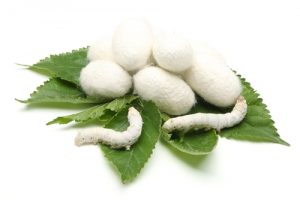Bad Bugs Being Good!
By Chris Williams on December 15, 2011.
A pest is a pest only if someone thinks it is! Insects and mites that are pests in one situation can be useful in another, sometimes even providing important commercial products. The honeybee is the best known example. It pollinates crops and provides honey. There are a number of less famous insects and mites that provide us with valuable products, as well:
The silkworm gives us silk fabric – The silk industry in the Orient depends on cultivation of the larvae of the silkworm moth. The moth caterpillar is fed mulberry leaves, and when mature, spins a cocoon around itself. A single silk filament forms the cocoon and ranges in length from 800 to 1200 yards. Silk workers unwind the cocoon, twisting several filaments into threads of raw silk for fabric production.
The fruit fly gives us wine – The small fruit fly breeds in vinegary or fermenting foods and can be a major pest in homes, restaurants, canneries, and breweries. In wineries, it’s usually a pest but sometimes a blessing. Some winemakers use the fruit fly to spread certain yeast spores in the grapes, making fermentation possible.
The lac insect gives us shellac – The lac insect is a scale insect that feeds on trees. Large numbers of the scales cluster together and secrete a resinous material that covers their bodies. This resin, called lac, is harvested twice a year and is ultimately processed into shellac and varnish.
 The cochineal insect gives us red dye – An insect related to the lac insect feeds on cactus and is the source of a red dye that was once used extensively as a coloring agent in cosmetics, beverages, and fabrics. The red dye is made from the dried, pulverized bodies of the cochineal insect. It takes 70,000 insects to make one pound of dye.
The cochineal insect gives us red dye – An insect related to the lac insect feeds on cactus and is the source of a red dye that was once used extensively as a coloring agent in cosmetics, beverages, and fabrics. The red dye is made from the dried, pulverized bodies of the cochineal insect. It takes 70,000 insects to make one pound of dye.
The cheese mite gives us Altenburger cheese – The cheese mite on the one hand is a major pest of cheese, giving it an “off” taste. On the other hand, the cheese mite is purposely added to aging Altenburger cheese to give the cheese its particular “piquant” bite.
The dermestid beetle helps in museums – Dermestid beetles feed on dead animals and dried animal products like furs and skins. It is a major pest in museums where it destroys artifacts. The same characteristics that make it a pest also make it useful. Museum curators and biologists us the beetles to clean animal skeletons for study. The larvae remove every bit of hair, flesh, and tissue on a specimen without damaging its delicate bone structure.